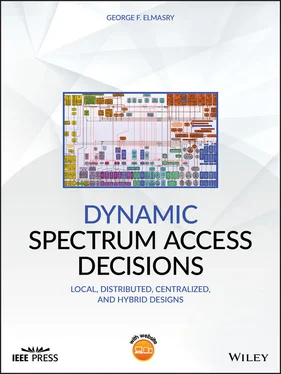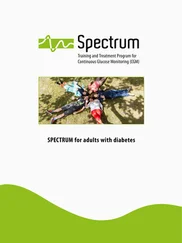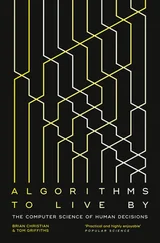DSA is being deployed and enhanced in many commercial and defense systems. Cellular long‐term evolution (LTE) and fifth‐generation (5G) literature shows myriad DSA approaches that are combined with beam forming, multiple input and multiple output (MIMO) antennas, and arbitration by the base station for efficient spectrum use. The United States (US) Defense Advanced Research Projects Agent (DARPA) next‐generation (XG) program is one example of defense initiatives for developing cognitive DSA radios. In both commercial and defense systems, DSA techniques are still evolving. There will always be room for further enhancement of DSA techniques in existing systems and for the development of better DSA techniques in new systems.
One goal of this book is to decouple DSA from cognitive radios and cognitive networks as covered in Part 1. The literature often presents DSA as the only drive behind cognitive radios. Even the US Federal Communications Commission (FCC) early definition of cognitive radio is based on the radio being able to opportunistically use unlicensed spectrum. There could be systems that lack the definition of being cognitive systems, which can use a form of DSA. Also, as cognitive wireless communications systems evolve, they should not be viewed as solely DSA systems. Chapter 4 explains the use of a form of “cognitive” reactive routing, which is built on top of DSA. The use of this reactive routing technique with military wireless communications systems enhances these systems' low probability of detection (LPD) and low probability of interception (LPI) capabilities.
This book is meant for a reader who has basic knowledge of wireless communications and wireless networks, and has an interest in the design and implementation of the physical layer and medium access control (MAC) layer of wireless communication systems to include cognitive radios and cognitive networks. Regardless of whether the system under design is being targeted to use a licensed spectrum band or an opportunistic spectrum band, there is a need to consider DSA. It is more obvious that a system built to use opportunistic spectrum would need DSA capabilities. However, the design of systems such as cognitive mobile ad‐hoc networks (MANETs) with allocated frequency bands has to consider the cooperative use of the allocated frequency bands to maximize the effective bandwidth of the formed network.
This book presents the most generic model to consider for DSA design. This model represents a large‐scale collection of heterogeneous hierarchical MANETs that use a mix of licensed and unlicensed spectrum bands. With this model, DSA becomes a set of cloud services that can span from the network edge to the network core and to a single centralized point (root) in the network core. With this generic model, DSA decisions can be made anywhere in the network. An entity making a DSA decision can use local information, information shared with and obtained from peer nodes in a cooperative distributed manner, or information obtained from lower or higher hierarchical entities. With this model, the most studied comprehensive case of DSA, which is the cellular 5G DSM, can be seen as a special case of this generic model. The first chapter in the second part of this book introduces this generic model followed by a chapter dedicated to 5G DSM.
1.1 Summary of DSA Decision‐making Processes
One aspect of optimizing DSA performance is to turn every node in every network into a spectrum sensor. The technology of spectrum sensing has evolved very well lately where a small size chip can perform comprehensive spectrum sensing techniques with minimal requirements on the node size, weight, and power (SWaP). The IEEE DySPAN standardization has a working group that defined the interface between a sensing hardware and the node module that is responsible for interfacing to the sensing hardware. This node module can be a distributed cognitive agent or a mere information collection agent.
Spectrum sensing can be tabulated under two main categories. The first category is augmented sensing where specialized spectrum sensing hardware/software is used as mentioned above. The second category is same‐channel in‐band sensing . With same‐channel in‐band sensing, the physical layer metrics of a received communication signal are leveraged to generate spectrum sensing information. This is a form of piggybacking of spectrum sensing over the ongoing communications signal, which should only require some processing of the physical layer metrics to obtain valuable spectrum sensing information. A comprehensive DSA solution may rely on both augmented sensing and same‐channel in‐band sensing. The advantages of same‐channel in‐band sensing, even in the presence of a specialized spectrum sensing hardware for augmented sensing, are detailed in this book.
There are two main components of the DSA design to consider. The first component pertains to obtaining spectrum sensing information from a sensor and being able to configure the sensor on what frequency bands to sense and what parameters to send to the distributed agent interfacing to the sensor. The second, and more challenging, DSA component is what to do with the obtained spectrum sensing information. This is sometimes referred to as decision fusion (DF). DF is a critical part of designing DSA capabilities where the design has to consider the following decision‐making types:
1 Local decisions. With this decision type, an agent can make a local decision to overcome interference detected on a utilized frequency band. This agent can make decisions such as increasing transmission power or switching to a different frequency band. In a MANET, a node can suggest to peer nodes to switch to the new frequency band based on its local DF using some OTA protocol. The switch to the new frequency occurs without relying on any external information that can be obtained from a higher or a lower hierarchal entity. Peer nodes can also be listening on a group of frequencies and synch to the new frequency without the need for any OTA control traffic transmission.
2 Distributed cooperative decisions. With this approach, a distributed cognitive agent will share spectrum sensing information, or a subset or processed version of it (fused spectrum sensing information), with peer distributed agents in the same network and cooperatively make a distributed decision to avoid a frequency band or to use a new frequency band. These cooperative decisions take into consideration that all nodes in the network have to synchronously switch to the new frequency.
3 Centralized decisions. With this decision type, spectrum sensing information is forwarded to a centralized entity (e.g., a network manager or a spectrum allocation arbitrator). The decision to use a frequency band or to stop using a frequency band is made with a bird's eye view (global view) of the status of spectrum use. This aspect of DSA is specifically needed when we have heterogeneous networks and there is no solution to create an equilibrium, using gaming theory implementation, between distributed agents' request for increased spectrum use. Without a centralized arbitrator, some networks can be making noncooperative decisions with respect to external networks that can result in “spectrum hugging”. With this case, the spectrum arbitrator is more suited to ensure spectrum usage is fairly optimized with respect to a large‐scale deployment of heterogeneous networks.
4 Hybrid decisions. With this approach, a mix of the above three decision types is considered in the DSA design. The balance between how much of each of the above three decisions types to use in a hybrid DSA design depends on the systems under design. As this book shows, DSA decisions can become a set of cloud services. The designer has to consider that the best approach to create DSA services 2in a large system is to use hybrid DSA decisions that adapt to the current state of the network of networks. This hybrid approach should make DSA services always available at any network entity regardless of the conditions of the control plane used to communicate DSA control traffic. 3
Читать дальше












